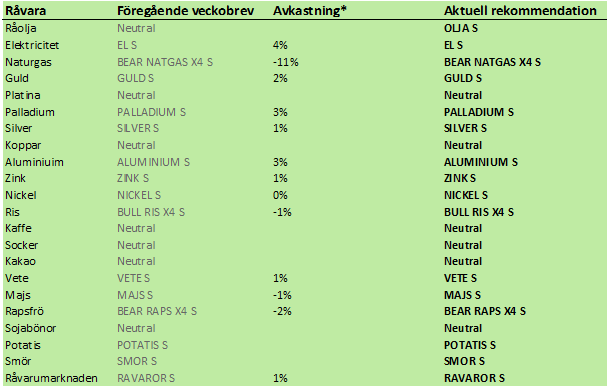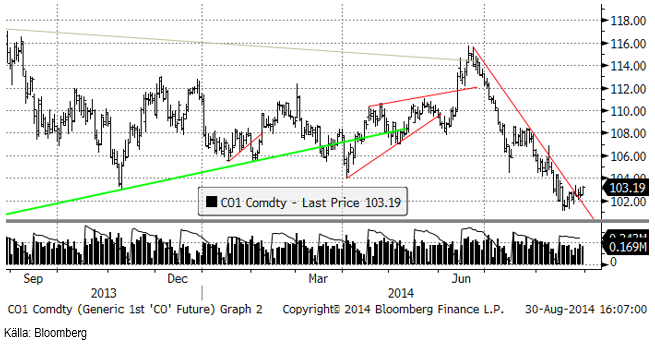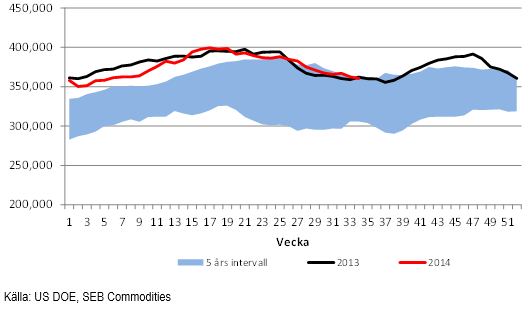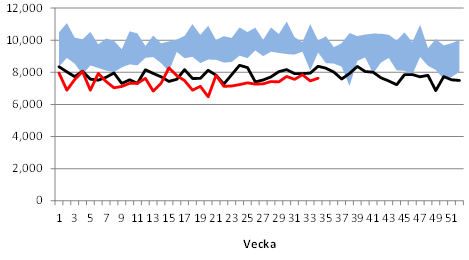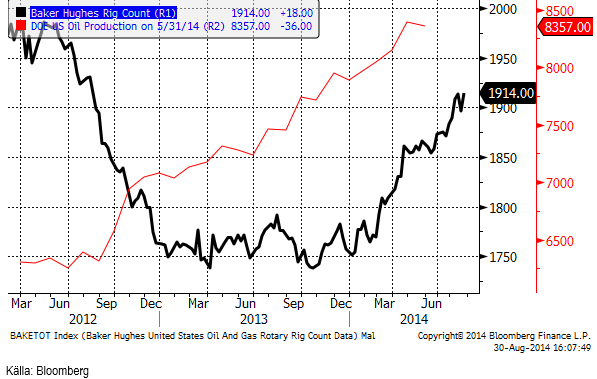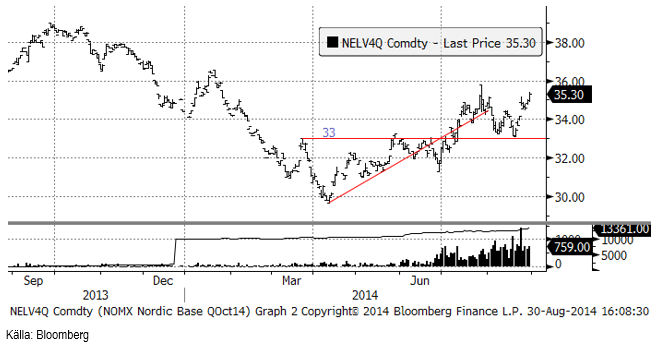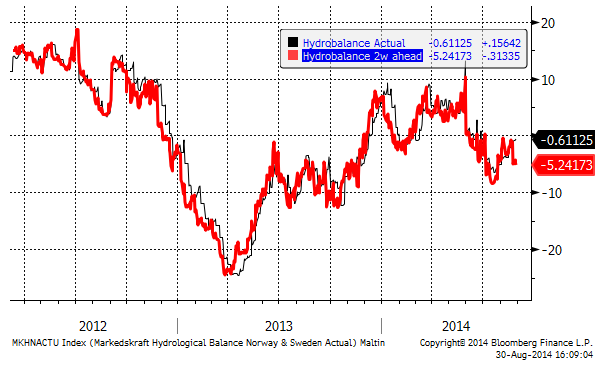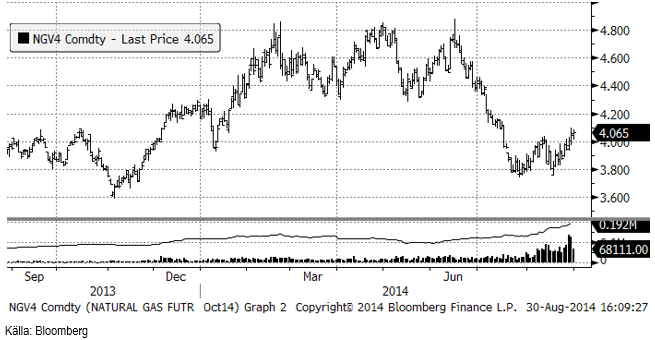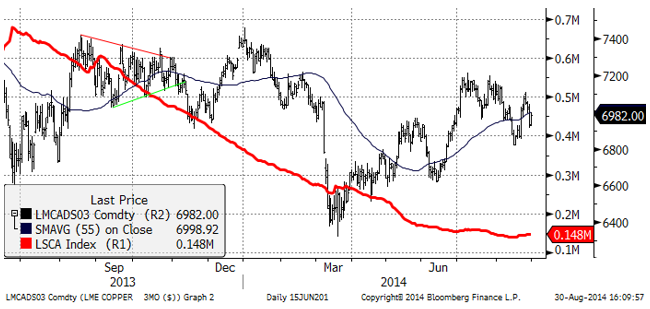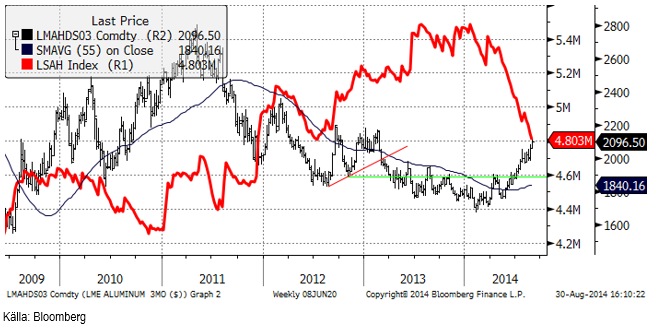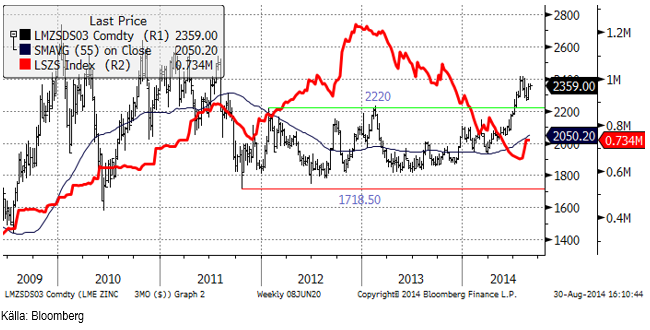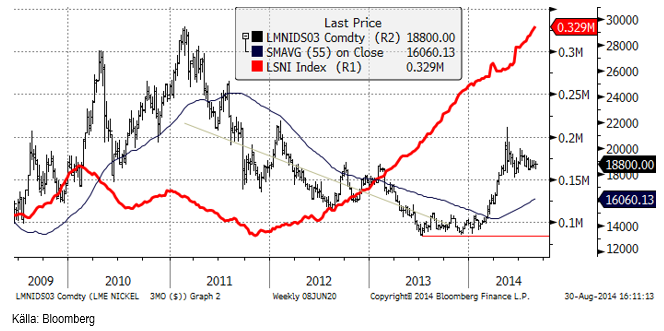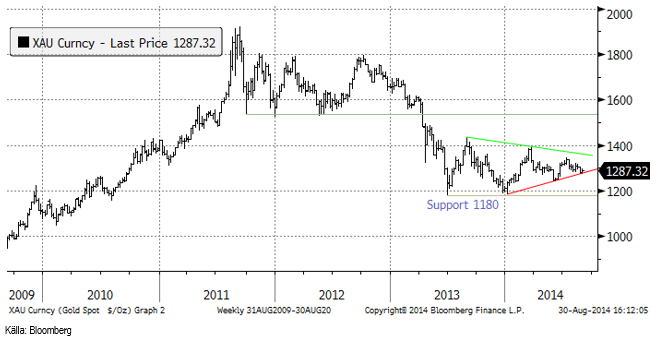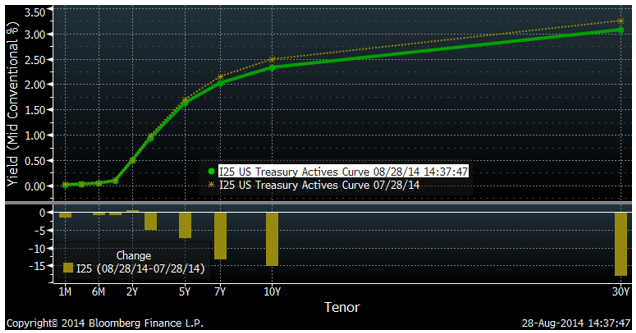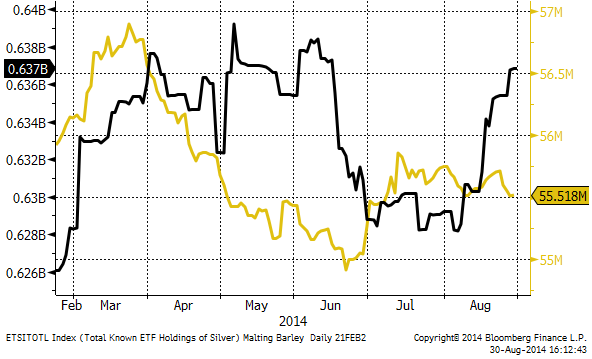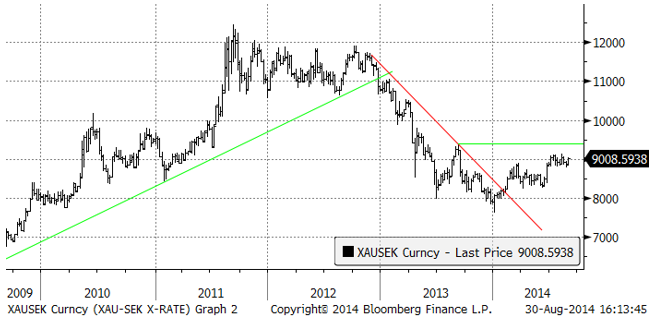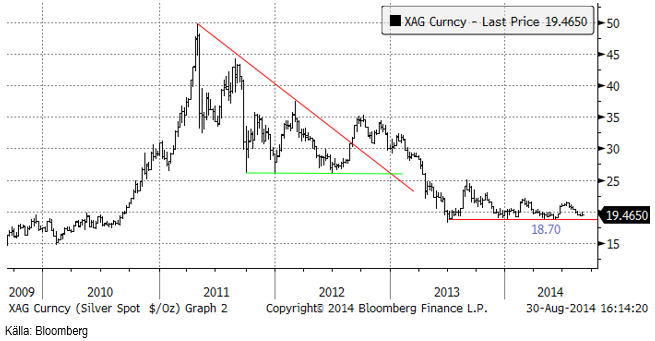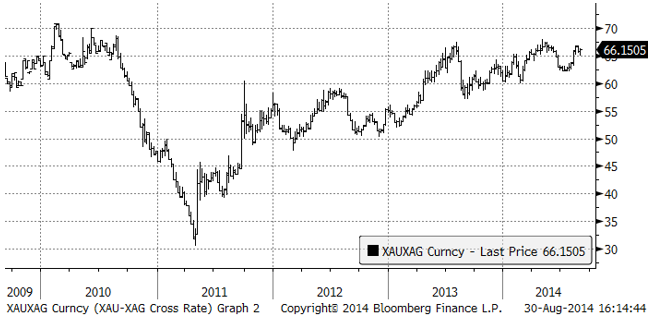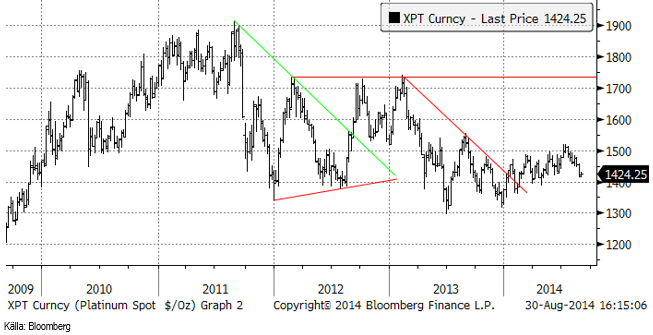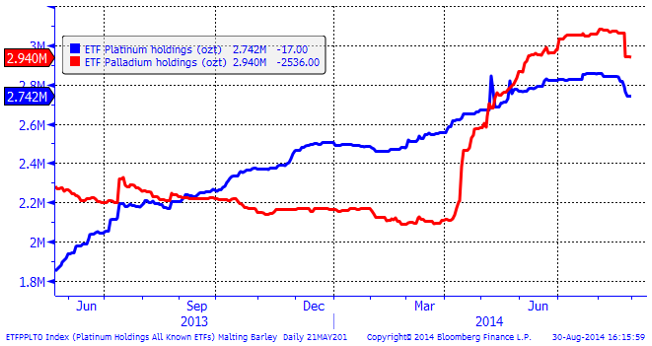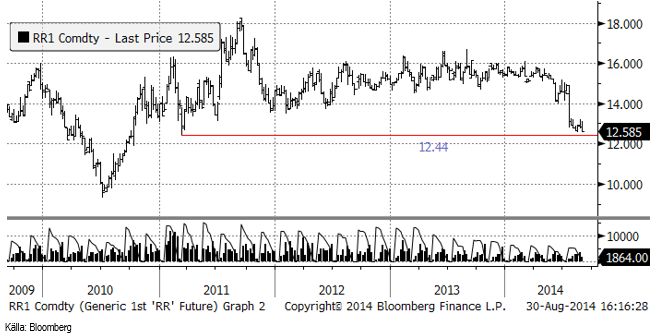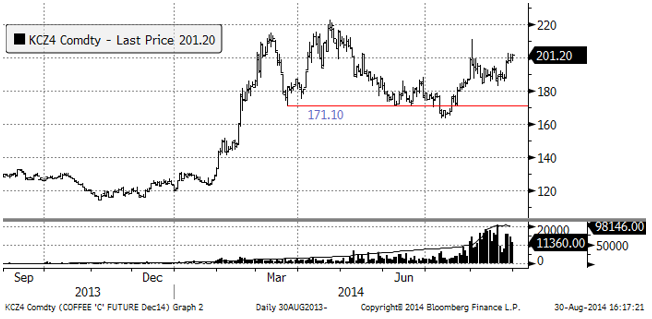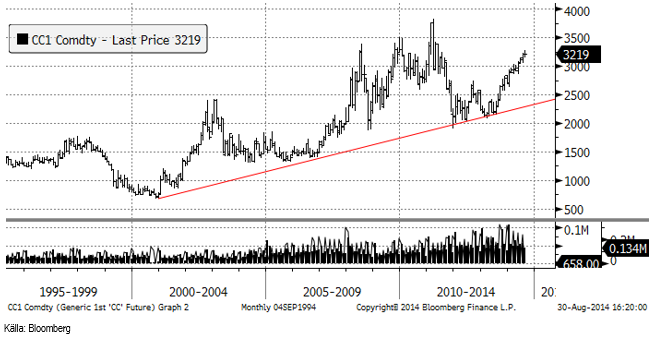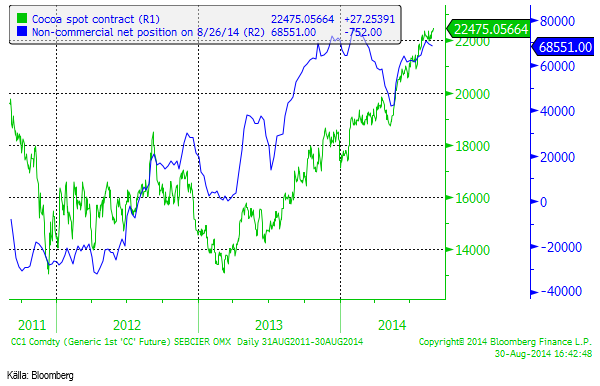Analys
SEB – Råvarukommentarer, 1 september 2014
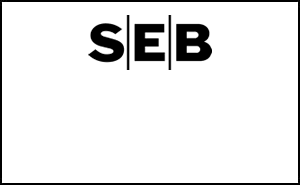
Rekommendationer
Kort sammanfattning
Pga tilltagande geopolitisk oro tror vi att ädelmetaller och olja är bra att vara köpt på råvarumarknaden. Det finns ingen uppenbar råvara att vara kort den här veckan. SILVER S och OLJA S är alltså de rekommendationer vi vill lyfta fram.
Råolja – Brent
Oljepriset har brutit motståndet för den nedgång som varit sedan juni. Vi tror att det finns potential för uppsida och det motiveras bland annat av att OPEC har producerat maximalt och det finns en viss sårbarhet med ISIS som motor i MENA. Libyen känns också skakigt då t ex den amerikanska ambassaden i Tripoli intogs i helgen. Slutligen har vi Ryssland/Ukraina-krisen och vinter på norra halvklotet på väg.
Råoljelagren i USA sjönk 2 mbbl till 360.5 mbbl. Nu är lagernivån faktiskt 1.5 mbbl lägre än samma vecka förra året.
Importen av olja ökade 0.2 mbbl i veckans rapport från DOE, men ligger 0.7 mbbl under förra årets nivå samma vecka. Man brukar se en ökning av importen under juni, juli och augusti och en topp i alldeles i slutet av augusti. Under september, oktober, november och december, faktiskt ända fram till mitten av mars, minskar importen successivt. Det är möjligt att USA:s veckovisa import når ner till 6 mbbl någon gång under den här perioden. Det var väldigt nära den nivån i mitten av maj i år.
Nedan ser vi ett diagram på antalet oljeriggar i USA, enligt Baker Hughes statistik (svart) och USA:s oljeproduktion enligt US DOE på 8.357 mbpd. Antalet borr-riggar steg återigen över 1900.
Vi rekommenderar alltså på kort sikt köp i olja, t ex via OLJA S.
Elektricitet
China minskar ytterligare på koleldad elkraft. Samtidigt kämpar 50% av kolgruvorna i världen med lönsamhetsproblem. Terminerna för kol i Europa har fallit till 80 dollar per ton för kalenderår 2015. I Euro-termer har kolpriset varit stabilt, men euron har varit svag då den svaga tillväxten i EU tynger. Ukrainakrisen tynger lite extra, men vintern är i antågande och Ukrainakrisen skapar också oro för energitillförseln.
På kort sikt tror vi att elpriset faktiskt testar och troligtvis bryter motståndsnivåerna.
Hydrologisk balans har enligt 2-veckors prognosen försvagats.
Vi rekommenderar köp av EL S om priset kommer ner lite.
Naturgas
Naturgaspriset har inte alls gått åt vårt håll den senaste veckan, men rekylen uppåt borde stöta på patrull vid 4.20, som är ett tekniskt motstånd. Med viss tvekan håller vi fast vid vår investering i t ex BEAR NATGAS X4 S.
Koppar
Kopparmarknaden ägnade förra veckan åt konsolidering efter den senaste tidens prisuppgång. Kanske funderar marknadens aktörer på vad orsaken var till den plötsliga prisuppgången, om det var något annat än att några hamnade snett i en annars ganska ”tight” marknad. Marknaden har varit i backwardation hela året och det gör det dyrt att ha en kort position. Utbudet kommer dock att öka, bland annat på grund av återupptagningen av export från Grasberg-gruvan. Vi kan dock inte riktigt se att detta kommer att leda till prisfall i kopparmarknaden. Konsumtionen väntas också växa i en hygglig takt och som vi har påpekat förut – risken finns att Kina börjar köpa metall till sina strategiska lager. Det räcker med möjligheten för detta, för att stabilisera marknaden på nedsidan.
Vi rekommenderar neutral position i koppar.
Aluminium
Konsumenterna av aluminium väntar på att priset ska falla tillbaka så att de kan prissäkra sig. Priset har dock gått upp varje dag de senaste två veckorna, bortsett från en dag. Sammantaget är prisuppgången 6% på två veckor, vilket är mycket för aluminium som vanligtvis är den minst volatila av basmetallerna. Premien för fysisk metall (US Midwest) ligger på 450 dollar per ton, vilket är 150 dollar mer än före sommaren, vilket tyder på att det finns ett oväntat sug efter metall. Många konsumenter lever antagligen ”ur hand i mun” och försöker köpa så lite som möjligt. Det betyder att nedgångar kan bli grunda, då dessa passar på att köpa.
Tekniskt ger trendkanalen motstånd vid 2175 dollar just nu, vilket är ytterligare 3% över dagens nivå. .
Vi fortsätter alltså med köprekommendation på ALUMINIUM S.
Zink
Zinkpriset närmar sig brytpunkt. Handeln var fast hela förra veckan. Vid sidan av aluminium är zink den mest populära metallen bland investerare för närvarande. Liksom i aluminium börjar en bättre fundamental balans att märkas. Ökad smältverksproduktion i Kina motverkar dock i någon mån den här processen. Trots detta är trenden klar, och det borde finnas utsikter för högre pris på zink. Tekniskt ser diagrammet ut att vilja bryta motstånden och gå högre. Ett brott av 2170 dollar / ton skulle signalera ytterligare ett kliv uppåt i prisnivå.
Vi rekommenderar köp av ZINK S.
Nickel
Den indonesiska handelskammaren har föreslagit att den nya regeringen ska tillåta export av nickelmalm. Villkoret för att få exportera malm ska enligt förslaget vara att exportören förbinder sig att bygga smältverk i Indonesien och att man betalar in 10% av investeringskostnaden till en investeringsfond. Företag måste också betala en exportskatt på 50-60%.
Den här nyheten är naturligtvis negativ för nickelpriset. Däremot blir det knappast billigt att exportera, men att möjligheten finns gör att sannolikheten för stora prisuppgångar i nickel minskar. Om priset går upp kraftigt pga materialbrist, kommer det att gå att få material från Indonesien. Marknaden tyckte uppenbarligen inte att nyheten skulle förändra utbuds- och efterfrågebalansen i nuvarande läge och priset förändrade sig inte mycket av den här anledningen på fredagen.
Guld
Priset på guld ligger fortfarande och testar den nedre gränsen i den triangelformation som bildats sedan mitten av förra året. Det är ännu oklart om det kommer att bli ett utbrott på nedsidan eller på uppsidan. Just nu är det som sagt väldigt nära till ett brott nedåt. Det innebär att taktiken är att köpa, men vara beredd att snabbt ta förlusten om det blir ett brott på nedsidan.
Tilltagande geopolitisk oro borde gynna guld som investering. Å andra sidan är det märkligt att guldpriset inte redan har stigit mer än det har. Om man bara tittade på prisutvecklingen på guld, skulle man tro att världen var ovanligt fridfull. Om man bor i Indien kan det kanske te sig så. Efterfrågan på guld i Indien hänger samman med monsunens utveckling. Den har varit svag hittills i år, som vi kunnat läsa tidigare. Nu kommer det dock att regna betydligt mycket mer än normalt de kommande två veckorna. Kanske kan detta ha en positiv påverkan på guldpriset.
Det talas om att räntorna är på väg uppåt i USA, men detta är inte något man ser i marknaden. Nedan ser vi räntekurvorna för amerikanska statspapper, där det tydligt framgår att räntorna generellt sett är lägre än för en månad sedan med ungefär 15 räntepunkter för 10 och 30 års obligationer.
Nedan ser vi att det varit inflöde i guldfonder (gul kurva, antal uns i ETF:er) under den senare delen av augusti. Vi har även märkt av att svenska placerare köpt guld, inte bara GULD S utan även fysiskt guld, vilket vi kan hjälpa till med för våra private bankingkunder.
Nedan ser vi guldpriset i svenska kronor per uns. Guld ser mer ”bullish” ut ur ett svenskt perspektiv, än ur ett dollarperspektiv.
Vi rekommenderar köp av GULD S.
Silver
Silver är vår favorit bland alla råvaror. Dels är har priset varit i konsolidering under mer än ett års tid efter prisfallet från toppnoteringen för tre år sedan, dels gynnas ädelmetaller av den förnyade och tilltagande geopolitiska oron och slutligen är silver billigt i förhållande till guld. Motståndet för nedgången från toppen 2011 är ännu inte bruten, men om eller när det sker, kan prisuppgången bli snabb och stor.
Det som särskilt lockar investerare till silver framför guld just nu är att silver är historiskt billigt jämfört med guld. Nedan ser vi ett diagram över priset på guld uttryckt i silver.
Vi anser att silver är mer köpvärt än guld och skulle vilja köpa på de här nivåerna. Vi rekommenderar köp av SILVER S.
Platina & Palladium
Platinapriset fann stöd och lyckades faktiskt stiga lite förra veckan, men trenden är trots detta nedåtriktad.
Prisdiagrammet på palladium ser vi nedan. Som vi ser gick priset över 900 dollar per uns och det talar för att prisuppgången kan fortsätta. 900 dollar var ett starkt motstånd.
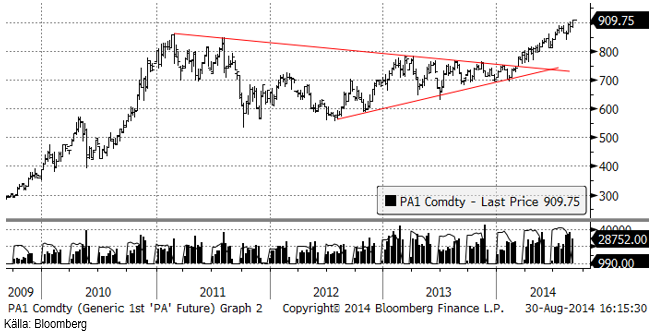
Nedanför ser vi hur mycket metall som finns i börshandlade fonder för platina respektive palladium. So vi ser har folk tagit hem sina vinster i båda den senaste veckan.
Vi är neutrala på platina men rekommenderar en köpt position i palladium.
Ris
Priset på ris (novemberkontraktet på CME) steg initialt men föll sedan tillbaka. Den statistik som kommit de senaste veckorna pekar på lägre skördar av ris i år. I veckan fick vi en sådan från Kina. Kinas tidiga risskörd minskade med 0.4% jämfört med förra året till 34 mt enligt National Bureau of Statistics i fredags.
Vi tycker inte att detta talar för ett fortsatt prisfall på ris, utan rekommenderar att man snarare investerar i RIS S.
Kaffe
Det är inga större nyheter på kaffefronten. Tekniskt ser vi att priset på decemberkontraktet tagit sig upp till 200 cent. Möjligen kommer priset att gå upp till 220 cent, där ett starkt motstånd finns. Fundamentalt ser vi dock inte något som talar för högre pris på kaffe.
Vi rekommenderar neutral position i kaffe.
Kakao
The International Cocoa Organization (”ICCO”) meddelade i fredags att 2013/14 kommer att ha ett produktionsöverskott på 40,000 ton och inte ett produktionsunderskott. Det beror på högre produktion än väntat i Elfenbenskusten. ICCO:s tidigare estimat var ett underskott på 75,000 ton. Marknadsföringsåret för kakao löper från den 1 oktober till 30 september.
Elfenbenskusten väntas enligt ICCO få en skörd på 1.73 mt (0.12 mt högre än tidigare väntat). Det innebär ett nytt rekord, i alla fall på papperet. Skörden 2010/11 kan ha varit högre, men det smugglades till grannländerna och skörden nu kan vara mindre, pga smuggling till Elfenbenskusten, enligt ICCO.
Även Ghana och Nigeria väntas få högre skördar, medan Kamerun och Ecuador får något lägre. Sammantaget gör ICCO en uppjustering av global produktion med 0.18 mt till 4.345 mt, vilket är ett nytt rekord. ICCO ser också att de afrikanska producenterna ökar sin produktionskapacitet och väntas fortsätta öka den 2014/15.
Globala lager ökar med 1.6 procentenheter till 38.9% av årlig konsumtion.
Spekulativ position ligger väldigt högt, historiskt sett.
Vi fortsätter med neutral position, men det börjar bli intressant att försöka sälja kakao om priset blir attraktivt. ”SHORT KAKAO A S” har en hävstång på -0.93 och kan vara ett lämpligt instrument att gå kort med.
För fler analyser på jordbruksråvaror se SEBs andra analysbrev.
[box]SEB Veckobrev Veckans råvarukommentar är producerat av SEB Merchant Banking och publiceras i samarbete och med tillstånd på Råvarumarknaden.se[/box]
Disclaimer
The information in this document has been compiled by SEB Merchant Banking, a division within Skandinaviska Enskilda Banken AB (publ) (“SEB”).
Opinions contained in this report represent the bank’s present opinion only and are subject to change without notice. All information contained in this report has been compiled in good faith from sources believed to be reliable. However, no representation or warranty, expressed or implied, is made with respect to the completeness or accuracy of its contents and the information is not to be relied upon as authoritative. Anyone considering taking actions based upon the content of this document is urged to base his or her investment decisions upon such investigations as he or she deems necessary. This document is being provided as information only, and no specific actions are being solicited as a result of it; to the extent permitted by law, no liability whatsoever is accepted for any direct or consequential loss arising from use of this document or its contents.
About SEB
SEB is a public company incorporated in Stockholm, Sweden, with limited liability. It is a participant at major Nordic and other European Regulated Markets and Multilateral Trading Facilities (as well as some non-European equivalent markets) for trading in financial instruments, such as markets operated by NASDAQ OMX, NYSE Euronext, London Stock Exchange, Deutsche Börse, Swiss Exchanges, Turquoise and Chi-X. SEB is authorized and regulated by Finansinspektionen in Sweden; it is authorized and subject to limited regulation by the Financial Services Authority for the conduct of designated investment business in the UK, and is subject to the provisions of relevant regulators in all other jurisdictions where SEB conducts operations. SEB Merchant Banking. All rights reserved.
Analys
A sharp weakening at the core of the oil market: The Dubai curve

Down to the lowest since early May. Brent crude has fallen sharply the latest four days. It closed at USD 64.11/b yesterday which is the lowest since early May. It is staging a 1.3% rebound this morning along with gains in both equities and industrial metals with an added touch of support from a softer USD on top.

What stands out the most to us this week is the collapse in the Dubai one to three months time-spread.
Dubai is medium sour crude. OPEC+ is in general medium sour crude production. Asian refineries are predominantly designed to process medium sour crude. So Dubai is the real measure of the balance between OPEC+ holding back or not versus Asian oil demand for consumption and stock building.
A sharp weakening of the front-end of the Dubai curve. The front-end of the Dubai crude curve has been holding out very solidly throughout this summer while the front-end of the Brent and WTI curves have been steadily softening. But the strength in the Dubai curve in our view was carrying the crude oil market in general. A source of strength in the crude oil market. The core of the strength.
The now finally sharp decline of the front-end of the Dubai crude curve is thus a strong shift. Weakness in the Dubai crude marker is weakness in the core of the oil market. The core which has helped to hold the oil market elevated.
Facts supports the weakening. Add in facts of Iraq lifting production from Kurdistan through Turkey. Saudi Arabia lifting production to 10 mb/d in September (normal production level) and lifting exports as well as domestic demand for oil for power for air con is fading along with summer heat. Add also in counter seasonal rise in US crude and product stocks last week. US oil stocks usually decline by 1.3 mb/week this time of year. Last week they instead rose 6.4 mb/week (+7.2 mb if including SPR). Total US commercial oil stocks are now only 2.1 mb below the 2015-19 seasonal average. US oil stocks normally decline from now to Christmas. If they instead continue to rise, then it will be strongly counter seasonal rise and will create a very strong bearish pressure on oil prices.
Will OPEC+ lift its voluntary quotas by zero, 137 kb/d, 500 kb/d or 1.5 mb/d? On Sunday of course OPEC+ will decide on how much to unwind of the remaining 1.5 mb/d of voluntary quotas for November. Will it be 137 kb/d yet again as for October? Will it be 500 kb/d as was talked about earlier this week? Or will it be a full unwind in one go of 1.5 mb/d? We think most likely now it will be at least 500 kb/d and possibly a full unwind. We discussed this in a not earlier this week: ”500 kb/d of voluntary quotas in October. But a full unwind of 1.5 mb/d”
The strength in the front-end of the Dubai curve held out through summer while Brent and WTI curve structures weakened steadily. That core strength helped to keep flat crude oil prices elevated close to the 70-line. Now also the Dubai curve has given in.

Brent crude oil forward curves

Total US commercial stocks now close to normal. Counter seasonal rise last week. Rest of year?

Total US crude and product stocks on a steady trend higher.

Analys
OPEC+ will likely unwind 500 kb/d of voluntary quotas in October. But a full unwind of 1.5 mb/d in one go could be in the cards

Down to mid-60ies as Iraq lifts production while Saudi may be tired of voluntary cut frugality. The Brent December contract dropped 1.6% yesterday to USD 66.03/b. This morning it is down another 0.3% to USD 65.8/b. The drop in the price came on the back of the combined news that Iraq has resumed 190 kb/d of production in Kurdistan with exports through Turkey while OPEC+ delegates send signals that the group will unwind the remaining 1.65 mb/d (less the 137 kb/d in October) of voluntary cuts at a pace of 500 kb/d per month pace.

Signals of accelerated unwind and Iraqi increase may be connected. Russia, Kazakhstan and Iraq were main offenders versus the voluntary quotas they had agreed to follow. Russia had a production ’debt’ (cumulative overproduction versus quota) of close to 90 mb in March this year while Kazakhstan had a ’debt’ of about 60 mb and the same for Iraq. This apparently made Saudi Arabia angry this spring. Why should Saudi Arabia hold back if the other voluntary cutters were just freeriding? Thus the sudden rapid unwinding of voluntary cuts. That is at least one angle of explanations for the accelerated unwinding.
If the offenders with production debts then refrained from lifting production as the voluntary cuts were rapidly unwinded, then they could ’pay back’ their ’debts’ as they would under-produce versus the new and steadily higher quotas.
Forget about Kazakhstan. Its production was just too far above the quotas with no hope that the country would hold back production due to cross-ownership of oil assets by international oil companies. But Russia and Iraq should be able to do it.
Iraqi cumulative overproduction versus quotas could reach 85-90 mb in October. Iraq has however steadily continued to overproduce by 3-5 mb per month. In July its new and gradually higher quota came close to equal with a cumulative overproduction of only 0.6 mb that month. In August again however its production had an overshoot of 100 kb/d or 3.1 mb for the month. Its cumulative production debt had then risen to close to 80 mb. We don’t know for September yet. But looking at October we now know that its production will likely average close to 4.5 mb/d due to the revival of 190 kb/d of production in Kurdistan. Its quota however will only be 4.24 mb/d. Its overproduction in October will thus likely be around 250 kb/d above its quota with its production debt rising another 7-8 mb to a total of close to 90 mb.
Again, why should Saudi Arabia be frugal while Iraq is freeriding. Better to get rid of the voluntary quotas as quickly as possible and then start all over with clean sheets.
Unwinding the remaining 1.513 mb/d in one go in October? If OPEC+ unwinds the remaining 1.513 mb/d of voluntary cuts in one big go in October, then Iraq’s quota will be around 4.4 mb/d for October versus its likely production of close to 4.5 mb/d for the coming month..
OPEC+ should thus unwind the remaining 1.513 mb/d (1.65 – 0.137 mb/d) in one go for October in order for the quota of Iraq to be able to keep track with Iraq’s actual production increase.
October 5 will show how it plays out. But a quota unwind of at least 500 kb/d for Oct seems likely. An overall increase of at least 500 kb/d in the voluntary quota for October looks likely. But it could be the whole 1.513 mb/d in one go. If the increase in the quota is ’only’ 500 kb/d then Iraqi cumulative production will still rise by 5.7 mb to a total of 85 mb in October.
Iraqi production debt versus quotas will likely rise by 5.7 mb in October if OPEC+ only lifts the overall quota by 500 kb/d in October. Here assuming historical production debt did not rise in September. That Iraq lifts its production by 190 kb/d in October to 4.47 mb/d (August level + 190 kb/d) and that OPEC+ unwinds 500 kb/d of the remining quotas in October when they decide on this on 5 October.

Analys
Modest draws, flat demand, and diesel back in focus

U.S. commercial crude inventories posted a marginal draw last week, falling by 0.6 million barrels to 414.8 million barrels. Inventories remain 4% below the five-year seasonal average, but the draw is far smaller than last week’s massive 9.3-million-barrel decline. Higher crude imports (+803,000 bl d WoW) and steady refinery runs (93% utilization) helped keep the crude balance relatively neutral.

Yet another drawdown indicates commercial crude inventories continue to trend below the 2015–2022 seasonal norm (~440 million barrels), though at 414.8 million barrels, levels are now almost exactly in line with both the 2023 and 2024 trajectory, suggesting stable YoY conditions (see page 3 attached).
Gasoline inventories dropped by 1.1 million barrels and are now 2% below the five-year average. The decline was broad-based, with both finished gasoline and blending components falling, indicating lower output and resilient end-user demand as we enter the shoulder season post-summer (see page 6 attached).
On the diesel side, distillate inventories declined by 1.7 million barrels, snapping a two-week streak of strong builds. At 125 million barrels, diesel inventories are once again 8% below the five-year average and trending near the low end of the historical range.
In total, commercial petroleum inventories (excl. SPR) slipped by 0.5 million barrels on the week to ish 1,281.5 million barrels. While essentially flat, this ends a two-week streak of meaningful builds, reflecting a return to a slightly tighter situation.
On the demand side, the DOE’s ‘products supplied’ metric (see page 6 attached), a proxy for implied consumption, softened slightly. Total demand for crude oil over the past four weeks averaged 20.5 million barrels per day, up just 0.9% YoY.
Summing up: This week’s report shows a re-tightening in diesel supply and modest draws across the board, while demand growth is beginning to flatten. Inventories remain structurally low, but the tone is less bullish than in recent weeks.


-

 Nyheter3 veckor sedan
Nyheter3 veckor sedanMahvie Minerals i en guldtrend
-

 Nyheter4 veckor sedan
Nyheter4 veckor sedanEurobattery Minerals satsar på kritiska metaller för Europas självförsörjning
-

 Nyheter4 veckor sedan
Nyheter4 veckor sedanGuldpriset kan närma sig 5000 USD om centralbankens oberoende skadas
-

 Nyheter4 veckor sedan
Nyheter4 veckor sedanOPEC signalerar att de inte bryr sig om oljepriset faller kommande månader
-

 Analys3 veckor sedan
Analys3 veckor sedanVolatile but going nowhere. Brent crude circles USD 66 as market weighs surplus vs risk
-

 Nyheter3 veckor sedan
Nyheter3 veckor sedanAktier i guldbolag laggar priset på guld
-

 Nyheter3 veckor sedan
Nyheter3 veckor sedanKinas elproduktion slog nytt rekord i augusti, vilket även kolkraft gjorde
-

 Nyheter3 veckor sedan
Nyheter3 veckor sedanTyskland har så höga elpriser att företag inte har råd att använda elektricitet


